Related Research Articles

Isabella d'Este was the Marchioness of Mantua and one of the leading women of the Italian Renaissance as a major cultural and political figure.
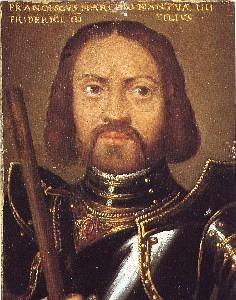
Francesco II Gonzaga was the ruler of the Italian city of Mantua from 1484 until his death.

Federico II of Gonzaga was the ruler of the Italian city of Mantua from 1519 until his death. He was also Marquis of Montferrat from 1536.

Infanta Beatrice of Portugal was a Portuguese princess by birth and Duchess of Savoy by marriage to Charles III, Duke of Savoy. She was the ruling countess of Asti from 1531 to 1538.

Maria of Portugal, Duchess of Viseu was an Infanta of Portugal, the only daughter of King Manuel I of Portugal and Eleanor of Austria. A noted patron of the arts and buildings, Maria's personal wealth rivaled that of her half-brother, King John III of Portugal, making her the richest woman in Portugal and one of the wealthiest princesses in Europe.

Osanna of Mantua was an Italian Dominican tertiary who gained notice as a stigmatic and mystic.
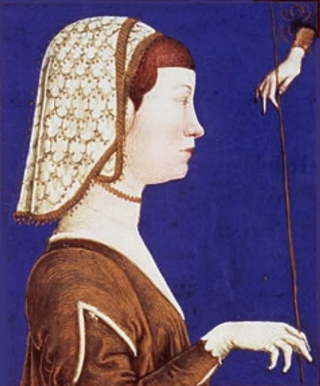
Eleanor of Naples was Duchess of Ferrara by marriage to Ercole I d'Este. She was the first duchess of Ferrara, and mother of many famous Renaissance figures. She was a well known political figure, and served as regent of Ferrara during the absence of her spouse.

Lorenzo Leonbruno, also known as Lorenzo de Leombeni, was an Italian painter during the early Renaissance period. He was born in Mantua (Mantova), an Italian commune in Lombardy, Italy. Leonbruno is most well known for being commissioned by the court of Francesco Gonzaga, Marquis of Mantua, and his wife Isabella d'Este. The patronage continued with their eldest son Federico II Gonzaga, who was the fifth Marquis of Mantua. Leonbruno was the court painter for the Gonzaga family from 1506–24.
Events from the year 1539 in art.
The captain general of the Church was the de facto commander-in-chief of the Papal States’ armed forces from the Middle Ages into the early modern period. The post was usually conferred on an Italian or other noble with a professional military reputation or (later) a relative of the pope.

Clara Gonzaga, Countess of Montpensier, Dauphine of Auvergne, Duchess of Sessa was an Italian noblewoman of the House of Gonzaga. She was the daughter of Federico I Gonzaga, Marquess of Mantua and the wife of Gilbert, Count of Montpensier.

Elisabetta Gonzaga (1471–1526) was a noblewoman of the Italian Renaissance, the Duchess of Urbino by marriage to Duke Guidobaldo da Montefeltro. Because her husband was impotent, Elisabetta never had children of her own, but adopted her husband's nephew and heir, Francesco Maria I della Rovere. She was renowned for her cultured and virtuous life.
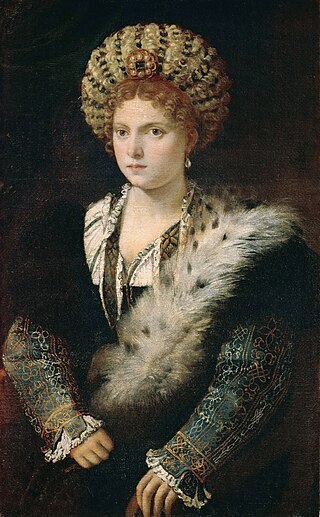
Isabella in Black is a portrait of a young woman by Titian. It can be dated to the 1530s and is in the Kunsthistorisches Museum in Vienna. The artist and the date are undisputed. Beyond the museum documentation, there are repeated doubts about the person depicted.
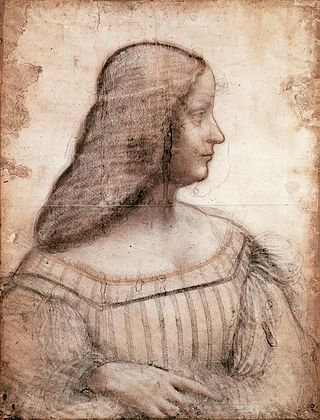
The Portrait of Isabella d'Este is a drawing by Leonardo da Vinci which was executed between 1499 and 1500. It depicts Isabella d'Este, Marchioness of Mantua. During the Italian Wars of 1499–1504, the French invaded Italy which caused Leonardo to flee from Milan to Mantua. There he had met Isabella, where she commissioned her portrait from him. Whether Leonardo completed the portrait is unknown. There is evidence through letters of the time that he held a fully completed painting of her, but they are vague in describing it. It is possible that the painting was lost to time or that it was, in fact, never completed at all. A version of the portrait in oils on canvas was found in a collection in Switzerland in 2015, but it has yet to be verified.

Margaret of Bavaria (1442–1479) was a Marchioness consort of Mantua, married in 1463 to Federico I Gonzaga, Marquess of Mantua. She was regent in the absence of her spouse during his military campaign in 1479.

Livia (Paola) Gonzaga was a Mantuan noblewoman.
Cecilia Mary Ady was an English writer, academic and historian. She worked at the University of Oxford, where she became known as an authority on the Italian Renaissance. She came to wider public attention after she was dismissed by a former friend from her college, and her colleagues supported her reinstatement.
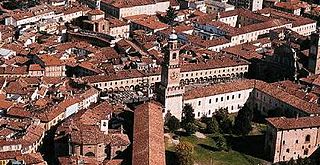
The Visconti-Sforza Castle is a mediaeval castle located in the centre of the city of Vigevano, Lombardy, Northern Italy. In the 14th and 15th centuries, members of the Visconti and Sforza houses, lords and dukes of Milan, transformed a previous fortification into a vast family resort. The castle was part of a wider plan of urban development for Vigevano, which included the erection of other buildings and the construction of the central Piazza Ducale.

Portrait of Federico II Gonzaga is a Renaissance portrait of a young boy by Francesco Francia in the Metropolitan Museum of Art in New York. The painter as author, the year 1510 and Federico II Gonzaga are considered to be sure, since conforming information is documented by numerous letters.

The Return of Judith to Bethulia is a painting by the Italian Renaissance artist, Sandro Botticelli. It was made around the year 1472, and preserved in the Uffizi in Florence.
References
- ↑ Descendants of Margaret Dymoke
- ↑ Emanuel, Angela (1989). A Bright Remembrance: The Diaries of Julia Cartwright, 1851-1924. London: Weidenfeld & Nicolson. p. 3.
- ↑ Mitchell, Rosemary (2004). "Cartwright, Julia Mary (1851–1924)" . Oxford Dictionary of National Biography (online ed.). Oxford University Press. doi:10.1093/ref:odnb/40620.(Subscription or UK public library membership required.)
- ↑ Emanuel, 36-37.
- ↑ Ady, Julia Mary Cartwright (1903). Isabella D'Este, Marchioness of Mantua, 1474-1539: A Study of the Renaissance. E.P. Dutton.
- ↑ Emanuel, 5; 12.
- 1 2 3 4 Dictionary of Art Historians Julia Cartwright Ady
- ↑ Cartwright, Julia (1989). A bright remembrance : the diaries of Julia Cartwright 1851-1924. Internet Archive. London : Weidenfeld and Nicolson. pp. book jacket. ISBN 978-0-297-79345-8.
- ↑ John Easton Law, Lene Østermark-Johansen Victorian and Edwardian responses to the Italian Renaissance Ashgate Publishing, Ltd., 2005 ISBN 0-7546-5057-X, 9780754650577
- ↑ Cartwright, Julia; Ady, Julia Mary Cartwright (1904). The Life and Art of Sandro Botticelli. Duckworth.
- ↑ Alambritis, Maria, ed. (3 June 2019). "Julia Cartwright (7 November 1851–28 April 1924)". 19: Interdisciplinary Studies in the Long Nineteenth Century. 2019 (28). doi: 10.16995/ntn.860 .
- ↑ Ady, Julia Mary Cartwright (1903). Isabella D'Este, Marchioness of Mantua, 1474-1539: A Study of the Renaissance. E.P. Dutton.
- ↑ Alambritis, Maria, ed. (3 June 2019). "Julia Cartwright (7 November 1851–28 April 1924)". 19: Interdisciplinary Studies in the Long Nineteenth Century. 2019 (28). doi: 10.16995/ntn.860 .
- ↑ Cartwright, Julia (1916). The Painters of Florence from the Thirteenth to the Sixteenth Century. E. P. Dutton & Company.
- ↑ Ady, Julia Mary Cartwright (1914). Italian Gardens of the Renaissance: And Other Studies. Scribner's.
- ↑ Ady, Julia Mary Cartwright; Cartwright, Julia (1896). Jean François Millet: His Life and Letters. Swan Sonnenschein. ISBN 978-0-608-34749-3.
- ↑ Benjamin G. Kohl, ‘Ady, Cecilia Mary (1881–1958)’, Oxford Dictionary of National Biography, Oxford University Press, Oct 2009 accessed 13 Nov 2016